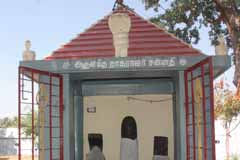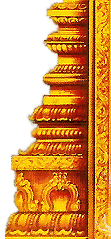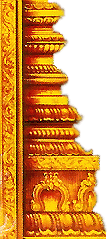|
|
Home >>
Murugan >
sri Subramania Swami temple
|
| |
- Details
- Path
- Map
- Photos
- Near By Temple
| |
| Sri Subramania Swami temple |
|
| |
|
![[Image1]](http://img1.dinamalar.com/Kovilimages/T_500_716.jpg)
|
| | |
| | | |
|
|
|
Moolavar | : |
Subramania Swami |
|
|
Urchavar | : |
- | |
|
Amman / Thayar | : |
- | |
|
Thala Virutcham | : |
- | |
|
Theertham | : |
- | |
|
Agamam / Pooja | : |
- | |
|
Old year | : |
500 years old | |
|
Historical Name | : |
Kumara koil | |
|
City | : |
Puthur, Usilampatti | |
|
District | : |
Madurai
| |
|
State | : |
Tamil Nadu |
| |
|
|
| |
|
|
 | Singers: |  |
| |
|
|
| |
- |
|
| |
|
|
 |
Festival: |
 |
| |
|
|
| |
Thaipoosam in January-February,Vaikasi Visakam in Fabruary-March, Tirukarthikai in November-December and Panguni Uthiram in March-April are the festivals celebrated in the temple. |
|
| |
|
|
 |
Temple's Speciality: |
 |
| |
|
|
| |
Lord Muruga graces in this temple with a sword in the hip, foot wears and an anklet worn by war heroes, a rare form of Muruga delighting His devotees. The temple has also a Shivalinga having in It all the features of Three Murthis, Sthanu (Shiva), Maal (Vishnu) and Ayan (Brahamma) collectively known as Thanu Maal Ayan. The Bana part (Linga) alone is there without the Stage called the Avudayar or Peeta. |
|
| |
|
|
 |
Opening Time: |  |
| | | | | |
The temple is opened from 6.00 a.m. to 11.00 a.m. and 5.00 p.m. to 7.00 p.m. |
|
| | | |
 |
Address: |  |
| | | | | |
Sri Subramaniaswami Temple, Usilampatti, Madurai. |
|
| | | |
 |
Phone: |  |
| | | |
| |
+91 - 4552 - 251 428, 98421 51428. | |
|
| | |
 |
General Information: |  |
| |
|
|
| |
Lord Kasi Viswanatha, Mother Visalakshi, Twin Vinayakas, Navagrahas the nine planets and Saneeswara – Saturn grace from their shrines in the corridor-prakara. There are also shrines for Naga Devadas.
|
|
| |
|
|
 |
Prayers |  | |
|
| | | |
Those habitually lack courage in nature and mentally confused pray to Lord in the temple.
| | |
|
| |  |
Thanks giving: |  | |
|
| | | |
Devotees perform abishek to Lord Muruga with milk and offer vastras. | | | |
| |  |
Greatness Of Temple: |  |
| |
|
|
| |
Lord Muruga graces as a war hero with sword in hip and an anklet at His feet, a rare form not generally seen in other Muruga temples. The deity was too furious then. To bring down the furious character of the Lord, during the reign of Tirumalai Naicker, His consorts Valli and Deivanai were installed and the sword was replaced with Vel traditionally attributed to Lord Muruga. On Thai Poosam day, special abishek called Mahabisheka is performed. The Shivalinga in the temple with the Bana part only without Peeta the Avudayar has all the combined grace of Shiva, Vishnu and Brahmma called Sthanu, Maal and Ayan. The three Lords gave darshan to Sage Agasthya together in this form, hence the Linga is also praised as Agasthya Lingam. Guardian deity Muneeswaran graces under the Iluppai tree. He is Aroopa – formless. Lord Kasi Viswanatha, Mother Visalakshi, Twin Vinayakas, Navagrahas the nine planets and Saneeswara – Saturn grace from their shrines in the corridor-prakara. There are also shrines for Naga Devadas.
|
|
| |
|
|
 |
Temple History: |  |
| |
|
|
| |
The king of the region was not able to control the atrocities of a powerful robber Nagasura who was harassing the people then. The king appealed to Lord Muruga to come to his rescue to protect the people. When the robber was looting the people, Lord came before him as a youth and demanded him to seek the pardon of the people for his wrong doings. It may be recalled from our scriptures that Lord Muruga did not destroy enemies immediately and gave them a chance to correct themselves. He did not destroy Surapanma too but changed him as a peacock for His vehicle and cock to play on His flag. Lord, here too warned the robber first. He was not able to bear the warning and took it as a humiliation meted out to him and began to attack the Lord but only met with his end. People took the youth to the king but he disappeared on the way. The king understood that the youth was no less a person than Lord Muruga Himself whom he was always praying. As the Lord appeared as a youth, the place was called Kumara Koil (temple of youth). As there were more ant-hills-puttru in Tamil, it also came to be known as Puthur.
|
|
| |
|
|
 |
Special Features: |  |
| |
|
|
| |
|
|
| |
|
|
|
| |
|
|
|
|
| | Location :
Usilampatti is 36 km from Madurai. Devotees should get down at the Vilampatti bus stop running between Usilampatti and Vepanuthu. The temple is near the bus stop.
Near By Railway Station :
Madurai
Near By Airport :
Madurai
Accomodation :
Madurai:
Pandian Hotel: +91-452-435 6789
Hotel Sangam: +91-452-253 7531; 424 4555
Hotel Tamilnadu:: +91-452-253 7461 – 5 lines
Hotel Supreme: +91-452-234 3151; 301 2222
Hotel Prem Nivas: +91-452-234 2532 and 3; 437 8787
Hotel Park Plaza: +91-452-301 1111; 234 2112
Hotel Northgate: +91-452-438 3030 (4 lines); 252 3030 (4 lines)
Hotel Keerthi: +91-452-437 7788; 437 8899
Hotel Golden Park: +91-452-235 0863
Hotel Rathna Residency:+91-437 0441 and 2; 437 4444
Hotel Jaya Sakthi: +91-452-230 0789
Hotel College House: +91-452-234 2971; 253 2759.
| |
| |
|
|
![[Gal1]](http://img1.dinamalar.com/KovilImages/GalleryThumb/G_T5_716.jpg)
|
|
 |
| மூலவர் முருகன் காலில் தண்டை |
|
|
|
|
 |
|
|
|
|
|





